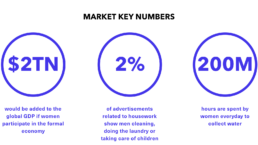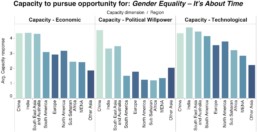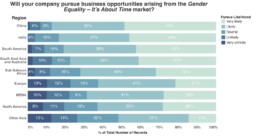In order to put gender equality into practice, innovative time- and labour-saving technologies can be deployed to reduce the uneven burden of domestic and care work on women. Moreover, progressive businesses must also take the lead in developing cultures, policies, and even advertising that break down gender norms leading to these disparate time burdens.
Women everywhere have a triple work burden in the productive, reproductive, and social spheres. In developing countries alone, women spend 100 million hours a day just carrying water. Women around the world spend 1 to 3 hours more per day on housework than men, and 2 to 10 times more caring for children, the elderly, and the sick. Unequal division of domestic and care work has significant negative impacts on girls and women. Indeed, if women’s participation in the formal economy were equal to that of men’s, an estimated 28 trillion USD would be added to global GDP.
The way to bring about more equality in the distribution of formal and informal work is to redistribute work and gender roles. There is an opportunity space for business to innovate products and services to reduce time on domestic and care work and to challenge gender roles and stereotypes.

Products and Services
For businesses, the need to reduce time on household chores and care work, specifically for women, carries with it an array of opportunities to innovate. Labour-saving technologies can contribute to freeing up time spent on domestic and care work in developing as well as developed countries.
It is products such as clean energy cookstoves, which do not require the use of firewood, and therefore save users time by avoiding wood collection, in India alone women spend 374 hours each year collecting firewood . Also products such as backpacks for carrying water ; and robotic floor cleaners that mop, sweep, or vacuum without supervision can all help alleviate the time burden of housework.
Solutions to reduce the time spend on care work is also part of this opportunity space. It is for instance low-cost childcare, which enables women to enter the labour market. Frontrunners are testing new kindergarten concepts that offer take-away healthy meals, offering breakfast to parents and children in a kindergarten café open 24 hours a day.
In marketing these products, business can play a role in challenging gender stereotypes. Just 2 percent of advertisements related to domestic and care work show men cleaning, doing the laundry, or taking care of children.
Several companies have had success branding their products in ways that challenge gender norms in recent years. One is Pantene working to actively challenge the labels and double standards that are holding women back.
Market Size and Demand Drivers
The smart appliances market is estimated to reach 37.2 billion USD by 2020, at a CAGR of 15.4 percent between 2015 and 2020. An important demand driver is the rise in women’s labour market participation. Women’s presence in the U.S. labour force, for instance, has increased dramatically, from 30.3 million in 1970 to 72.7 million during 2006-2010.
Survey Findings
According to our 2016 survey, respondents in South East Asia & Australia, and Europe are significantly more positive towards the potential benefits of developing time-saving measures to promote gender equality than other regions.

The political capacity to grow the market is perceived to be substantial in Europe, South East Asia & Australia. This could be an indication gender equality is particularly high on the agenda in these regions. Meanwhile, respondents in South East Asia, India, and China exhibit a strong confidence in the technological and economic capacity to pursue this opportunity.
While the market opportunity is not perceived to provide the most benefits to society, it represents one of the markets perceived to have a strong business case. According to the 2016 survey, it is a market opportunity likely to be pursued by business, yet its positive impacts on society are not seen as significant. This is the only market opportunity exhibiting such a large difference between these two variables of the 15 markets surveyed in 2016 . This disparity could signal that respondents believe the market is quite niche, with a more narrow impact on society.

The business case is perceived to be particularly strong by leaders in Europe, South East Asia & Australia followed closely by leaders in the North American market.
Looking at the sector perspective, it is clear the governmental sector and the service industry see the greatest benefits in pursuing this market opportunity.
In Sub Saharan Africa, civil society is expected to advocate most strongly for this market and in Europe the public sector will likely advocate for it most strongly.
This market was surveyed globally in 2016 by more than 5500 leaders from both the public and private sectors. The survey was conducted in collaboration with the research company YouGov. The survey results were originally published in the Global Opportunity Report 2017.

